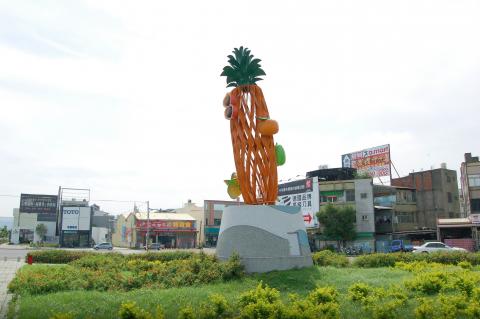Residents of Changhua County’s Yuanlin Township (員林) are not happy with a statue portraying various fruit that was erected at the intersection of Jhongshan and Jyukuang roads in the city, saying that it did not resemble the fruit it was supposed to.
The 7m tall statue — meant to represent a pineapple, a starfruit, a honey orange, a guava and a Chinese chestnut — is made of stainless steel and steel plates, and marks the entrance to a rezoned area that spans more than 184 hectares.
However, since its installation in March, residents in the township have complained that the “pineapple” was too thin and long, looking more like a carrot, and that it was too slanted and looked like it might topple over.

Photo: Tang Shih-ming, Taipei Times
There has also been criticism of how the two Chinese chestnuts attached to the pineapple made it look like the pineapple had eyes.
The guava part of the statue also came under criticism, with residents debating whether it looked more like a guava or a sweet jujube.
Township representative Chen Chiu-jung (陳秋蓉) said that aside from the starfruit and the honey orange appearing relatively normal, the other fruits in the statue were “ugly.”
Chen said she did not understand why the statue included a pineapple, because the township does not produce pineapples and added that it demonstrated ignorance of the township’s agricultural produce.
Changhua County Councilor Chen Su-yueh (陳素月) also criticized the statue, calling it “crude and ill-made” and a disgrace to all Yuanlin residents, adding a call for the county government to remove the statue and remake it.
Meanwhile, Yuanlin Township Secretary-General Lai Chih-fu (賴致富) said that while the inclusion of the pineapple might seem inappropriate, it was possible that the designer of the statue wanted to use the fruit to symbolize that good luck will come.
The word for pineapples in Hoklo (commonly known as Taiwanese) is ong lai, and is usually rendered into Mandarin with the characters wang lai (旺來) instead of fong li (鳳梨) because the word ong in Hoklo can also mean “prosperity.”
Lai also said that the township had told the county government earlier that several residents found parts of the statue to be “unlike the original fruit they were supposed to resemble.”
Changhua County Government Department of Land Director Wang Yin-ho (王銀和) said that the statue was a gift from the companies participating in the rezoning and cost about NT$5 million (US$173,000) to make.
The government had told the companies how the residents felt about the statue, and asked them to take those feelings into consideration and remove the statue, Wang said.
However, the artist who designed the statue insisted it was a work of art, Wang added.
Wang said the government respected the artist’s opinion, but took residents’ complaints seriously, and that the county government would continue to negotiate an acceptable resolution with the companies that commissioned the statue.

A strong continental cold air mass is to bring pollutants to Taiwan from tomorrow, the Ministry of Environment said today, as it issued an “orange” air quality alert for most of the country. All of Taiwan except for Hualien and Taitung counties is to be under an “orange” air quality alert tomorrow, indicating air quality that is unhealthy for sensitive groups. In China, areas from Shandong to Shanghai have been enveloped in haze since Saturday, the ministry said in a news release. Yesterday, hourly concentrations of PM2.5 in these areas ranged from 65 to 160 micrograms per cubic meter (mg/m³), and pollutants were

Taiwan’s armed forces have established response protocols for a wide range of sudden contingencies, including the “Wan Chun Plan” to protect the head of state, the Ministry of Defense (MND) said today. After US President Donald Trump on Saturday launched a series of airstrikes in Venezuela and kidnapped Venezuelan President Nicolas Maduro, concerns have been raised as to whether China would launch a similar “decapitation strike” on Taiwan. The armed forces regularly coordinate with relevant agencies and practice drills to ensure preparedness for a wide range of scenarios, Vice Minister of National Defense Hsu Szu-chien (徐斯儉) told reporters before a

EVA Airways on Saturday said that it had suspended a pilot and opened an investigation after he allegedly lost his temper and punched the first officer several times as their plane was taxiing before takeoff at Los Angeles International Airport. According to a report published on Thursday by The Reporter, the incident occurred after the flight’s Malaysian first officer tried to warn the Taiwanese pilot, surnamed Wen (文), that he was taxiing faster than the speed limit of 30 knots (55.6kph). After alerting the pilot several times without response, the first officer manually applied the brakes in accordance with standard operating

NOT AN OPENING: Trump’s violation of international law does not affect China’s consideration in attacking Taiwan; Beijing lacks capability, not precedent, an official said Taiwanese officials see the US’ capture of the president of Venezuela as a powerful deterrent to Beijing’s aggression and a timely reminder of the US’ ability to defeat militaries equipped with Chinese-made weapons. The strikes that toppled Venezuelan President Nicolas Maduro signaled to authoritarian leaders, including Chinese President Xi Jinping (習近平), US President Donald Trump’s willingness to use military might for international affairs core to US interests, one senior official in Taipei’s security circle said. That reassured Taiwan, the person said. Taipei has also dismissed the idea that Trump’s apparent violation of international law could embolden Beijing, said the official, who was not